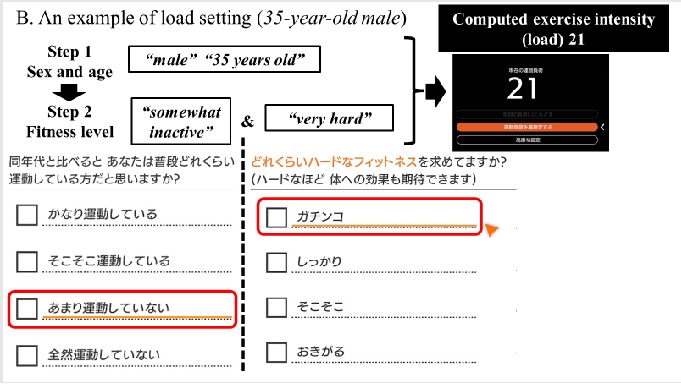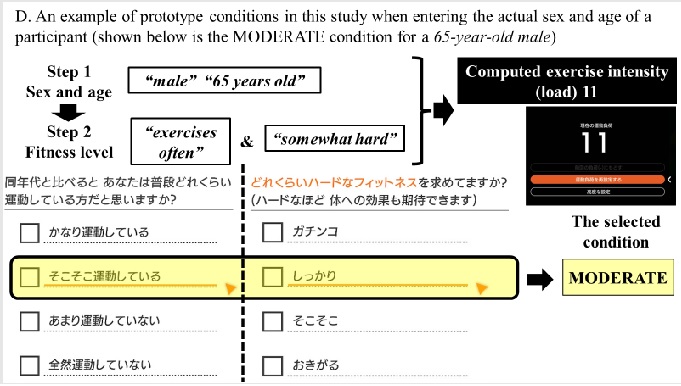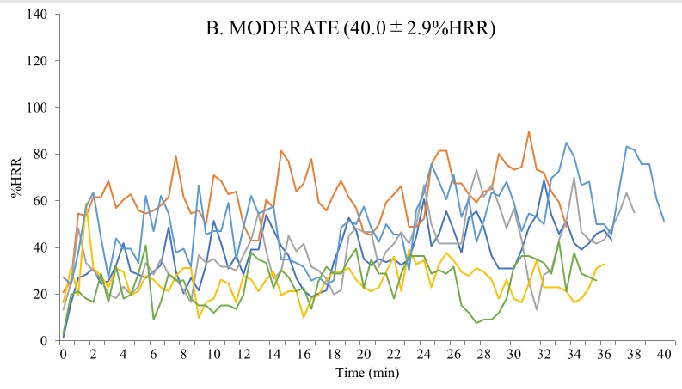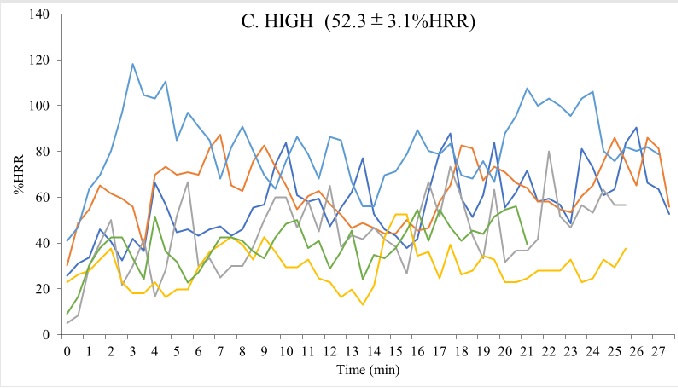Search for Articles
Article Clinical Medicine General Medicine Social Medicine
A proposal concerning exercise intensity with the Nintendo Ring Fit Adventure Exergame among older adults: A preliminary study
Journal Of Digital Life.2023, 3,12;
Received:August 8, 2023 Revised:September 5, 2023 Accepted:September 19, 2023 Published:October 13, 2023
- Togo Onishi
- Graduate School of Human and Social Sciences, Shimane University
- Daiki Fujiwara
- Faculty of Human Sciences, Shimane University
- Takafumi Abe
- Center for Community-Based Healthcare Research and Education (CoHRE), Head Office for Research and Academic Information, Shimane University
- Ryo Miyazaki
- Faculty of Human Sciences, Shimane University
Correspondence: miyazaki@hmn.shimane-u.ac.jp
Abstract
The Nintendo Ring Fit Adventure (RFA) (Nintendo, Kyoto, Japan) is a novel exergame that combines exercise and video game elements. Although previous RFA intervention studies have reported the health effects of the RFA, exercise intensity among older adults has not yet been documented. We hypothesized that the exercise intensity of older adults in the current RFA setting may be low. This preliminary study developed a range of prototype RFA intensity conditions and to evaluate exercise intensity among older adults. Six older adults (1 male/5 females, mean age 75.2±10.3 years old) participated in this study. Three RFA conditions were developed: "LOW" (the ‘default’ load. Older individual input actual gender and age), "MODERATE" (as defined by the American College of Sports Medicine [ACSM]: 40%-59% heart rate reserve [HRR]), and "HIGH" (highest exercise intensity that older individuals could set in the game). Exercise intensity was assessed using the %HRR. The results show that the %HRR values for the conditions were 34.9%±4.1% (LOW), 40.0%±2.9% (MODERATE), and 52.3%±3.1% (HIGH). In conclusion, this preliminary study showed that, among the three prototype RFA conditions, both MODERATE and HIGH conditions generally attain moderate or greater intensity for older adults when assessed using the heart rate.
keywords:
1. Introduction
The Ring Fit Adventure (RFA) (Nintendo, Kyoto, Japan) is a novel exergame (Benzing & Schmidt, 2018) that combines exercise and video game elements. Unlike traditional video games, which primarily involve fingertip operation, exergames require significantly higher energy consumption than the resting state. Compared to existing exergames, the RFA uniquely combines gameplay and exercise through the incorporation of strong role-playing game elements, enabling the protagonist’s growth within the game.
Launched in 2019, the RFA achieved substantial sales in 2020, largely due to the COVID-19 pandemic and related closures of gyms and other exercise facilities. As of 2023, the RFA has sold over 15 million units worldwide (Nintendo, IR Infomation). Exergames are recognized for their entertainment value and motivational potential, attracting attention as a new approach to improving health, especially among older adults (Nagano et al, 2018). Previous systematic reviews have reported improvements in the cognitive function and balance resulting from exergame use in older populations (Stojan et al, 2019; Liu et al, 2022). While two intervention studies on the RFA have already demonstrated significant health-promoting effects, including improvements in back pain among patients with chronic back pain (Sato et al, 2021) and enhanced physical fitness in university students (Wu et al, 2022), further research is warranted to assess the health benefits of the RFA in older adults.
Taking into account the fact that very few studies have so far been published on RFA, whether or not the exercise intensity settings in the RFA are actually appropriate for users, including older populations, remains uncertain. On the game setting screen in the RFA, users can adjust the exercise intensity (load) from 1 (weakest) to 30 (strongest) (Nintendo, Q&A). Unfortunately, older users following game instructions can only select slightly lower intensity exercises due to age-based load limits that are set conservatively for older adults. In addition, the exercise intensity algorithm used in the RFA is confidential, leading to ambiguity concerning the exercise intensity setting.
Although not directly related to the RFA, the existing literature provides limited guidance on exercise intensity settings in exergames. These previous studies (Sato et al, 2021; Wu et al, 2022) referred to exercise intensity in different exergames (Wii Fit and Wii Sports, Nintendo). For instance, Wu et al. (2022) described the RFA exercise intensity as follows: ‘Although the amount of exercise depends on the specific exercise intensity chosen by the player, it is generally set at 4 to 6 metabolic equivalents (METs)’ (Wu et al, 2022). A previous study found that the exercise intensity of Wii Sports is between 3 and 5 METs (Miyachi et al., 2010). However, this citation by Ainsworth et al. (Ainsworth et al, 2000) pertains to the METs of exergames unrelated to the RFA. Consistent with these previous studies (Ainsworth et al, 2000; Miyachi et al, 2010), it has been shown that the mean exercise intensity of the Wii Fit was 3.2±0.6 METs.
However, while these RFA intervention studies have reported some health effects (Sato et al, 2021; Wu et al, 2022), the exercise intensity in the RFA has not been documented. Consequently, the appropriateness of assuming the same intensity range for the RFA (4-6 METs) remains uncertain. Given the lack of specific evidence regarding the RFA exercise intensity settings in older adults, it is crucial to meticulously examine this issue.
Considering the aforementioned limitations observed in previous RFA studies (Sato et al, 2021; Wu et al, 2022), the current preliminary investigation sought to evaluate the suitability of exercise intensity in the RFA for older adults. To this end, we designed and implemented a diverse set of prototype RFA intensity conditions and assessed the exercise intensity experienced by older adults during each condition using the heart rate (HR) as a metric. Consequently, the primary objective of this preliminary study was to identify and propose an appropriate RFA intensity setting tailored to the needs of older adults.
2. Methods
2.1. Participants
The participants in this study were community-dwelling older adults residing in Matsue City, Shimane Prefecture. They were members of a community health class for older adults, which was overseen by a faculty member at Shimane University. This study was conducted using flyers and telephone calls. The inclusion criteria were as follows: 1) individuals ≥60 years old and 2) those who had not participated in any other exercise program in the previous 6 months. The exclusion criteria were as follows: 1) difficulty performing standing exercises involving bending and extending the knees, 2) resting systolic blood pressure of ≥180 mmHg, 3) contraindicated for exercise by a family physician, and 4) any other criteria considered inappropriate by the investigator. This study was approved by the Research Ethics Committee of the Faculty of Human Sciences of Shimane University (2022-3).
2.2. The RFA (Fig. 1)
The RFA incorporates the use of the Ring-Con and Leg-Band, which are equipped with built-in gyro sensors and acceleration sensors, thus enabling the detection of subtle human movements (Nintendo, Frequently Asked Questions about Ring Fit Adventure). There are two main types of exercise approaches with the RFA: “The Easy Mode,” featuring mini-games, and “The Adventure Mode”. We used the Adventure Mode, as described in previous studies (Sato et al, 2021; Wu et al, 2022). The Adventure Mode primarily involves aerobic exercises, such as jogging, and resistance exercises. During aerobic exercise, the leg band, affixed to the thigh, detects movements (acceleration), such as jogging, and the avatar on the game screen replicates this jogging activity. In battle scenes, the player is instructed to perform certain exercises, such as gripping the Ring-Con tightly, tilting it to the left or right, or squatting. By following these instructions, the player can effectively defeat enemies. Throughout the game, a combination of jogging and battles contributes to the player’s progress and advancement in different stages (Fig. 1).

2.3. Setting the exercise intensity with the RFA (Fig. 2AB)
With the RFA, users can freely select their exercise intensity according to their age, physical fitness, and desired exercise intensity (Fig. 2A). The exercise intensity setting in the RFA is determined using an algorithm developed by the manufacturer (Nintendo) and is executed as follows: during the initial screen setup, users input their age and sex (Step 1). Thereafter, the users input their exercise habits and desired exercise intensity (load) (Step 2). Based on these two steps, the load level (1-30) was determined automatically on a scale from 1 (weakest) to 30 (strongest). As the load level (1-30) increases, users are required to exert greater force on the Ring-Con to defeat enemies and perform more vigorous leg movements (e.g. jogging) to trigger responses from the leg band (the leg band response threshold adjusts accordingly). Specifically, young individuals (<65 years old) could choose any load level from 1 to 30 (e.g. load set to 21, as shown in Fig. 2B). However, for older adults (≥65 years old), the intensity choices are limited, as the system sets the maximum load setting to 15 or lower by default in this age group (refer to Table 1). Consequently, if an older individual selects a general setting (Options around the middle row in ‘Exercise habit’ and ‘Desired exercise intensity’), the RFA load will often be set very low, at approximately 3-5 (equivalent to low-intensity exercise for a middle-aged person, such as the lowest row in Fig. 2A) in most cases.


2.4. Study design
2.4.1. Experimental conditions (Table 1, Fig. 2CD)
In the present study, we established three intensity conditions of LOW, MODERATE, and HIGH. Fig. 2C illustrates the setup of the conditions used in our investigation. We hypothesized that the MODERATE condition would correspond to moderate intensity as defined by the American College of Sports Medicine (ACSM) (ACSM, 2018), based on the following rationale: first, we set the LOW condition (the ‘default’ load) to represent the general intensity of older players (≥65 years old). To achieve this, we incorporated the actual gender and age of the older participants, resulting in a load of approximately 3-5, as shown in Table 1. Second, the HIGH condition was configured to represent the highest intensity suitable for older players (≥65 years old) in the RFA setting. We assumed that the HIGH condition would elicit a vigorous intensity (≥60% heart rate reserve [HRR]). Finally, the MODERATE condition was determined as an intermediate level between the LOW and HIGH conditions, targeting moderate intensity (40%-59% HRR) (ACSM, 2018).
To assess these conditions, two researchers (TO and DF) conducted preliminary playing tests. During these tests, they entered the age and sex of older players and set the load (1-15) accordingly. The HR and rating of perceived exertion (RPE) were recorded during preliminary tests. While configuring the load in the RFA, various combinations were available based on the options of “exercise habit” and “desired exercise intensity” (Fig. 2A). For ease of testing, we selected convenient combinations of “exercise habit” and “desired exercise intensity” within the same row (Fig. 2CD). Notably, the combination with the lowest intensity (“inactive ” × “very light”) was excluded because it had the lowest load (1) (Fig. 2C).


Table 1. Conditions and exercise intensity (load)

Table Footnote: Values presented are for males. For females, all values are adjusted to 1 less than the male values. It is important to note that all values, including age groups and load values, are derived from the RFA setting screen. Although guidance regarding how to adjust the loads is available from the manufacturer (Nintendo, Q&A), the details regarding the load settings algorithms have not yet been disclosed. Therefore, the values displayed are based on preliminary tests conducted by the two researchers before the commencement of the present study. Please refer to Fig. 2 for detailed information on how the conditions were configured.
2.4.2. Experiments and measures
Upon arrival at the designated venue, the participants were instructed to rest for at least 30 min before engaging in RFA play under the three conditions (LOW, MODERATE, and HIGH) in a predetermined order (from LOW, MODERATE, to HIGH). Participants played under each condition for approximately 30 min, with a break of at least 30 min between conditions. The load for each condition was determined by inputting the participants’ actual “gender” and “age” into the RFA setting screen.
During RFA play, HR measurements were taken, including the resting HR and HR every 30 s during exercise. In addition, the RPE was recorded immediately after the completion of each condition. Consistent with a previous study (Onishi et al, 2022), the participants wore a Polar OH1 heart rate monitor (Polar Electro Inc., Bethpage, NY, USA) on their upper arms. HR data were transmitted to the Polar Team application on a tablet device (Polar Electro Inc.) for recording.
The exercise intensity was evaluated by converting HR measurements (every 30 s) to the %HRR. Following the ACSM guidelines (ACSM, 2018), exercise intensity based on the %HRR was categorized as follows: low-intensity (<40% HRR), moderate-intensity (40%-59% HRR), and vigorous-intensity (≥60% HRR). The participants’ maximum HR was estimated using the formula “220 – age” (Fox et al, 1971).
2.5. Statistical analysis
Continuous data were presented as the mean ± standard deviation (SD). For the HR, the data were derived from the actual time spent exercising (jogging and battle scene) from the beginning to the end of the exercise session. HR measurements obtained during simple standing and waiting periods, such as during the RFA tutorial screen, were excluded from the dataset.
3. Results
The study included 6 older adults (1 male and 5 females) with a mean age of 75.2 ± 10.3 (range, 63–88) years old and a body mass index (BMI) of 21.6 ± 2.2 kg/m². Fig. 3A-C illustrates the HR changes (%HRR) during the experiment for these six participants. The mean %HRR values for the 3 conditions were as follows: 34.9 ± 4.1% (LOW), 40.0% ± 2.9% (MODERATE), and 52.3% ± 3.1% (HIGH) (Fig. 4). In addition, the RPE values were 12.7 ± 2.3 (LOW), 13.7 ± 1.2 (MODERATE), and 14.4 ± 2.6 (HIGH).




4. Discussion
We investigated the HR responses of older adults under our prototype RFA intensity conditions. As anticipated, the MODERATE (40.0% ± 2.9% HRR) and HIGH (52.3% ± 3.1% HRR) conditions achieved moderate intensity (40%-59% of HRR) and were deemed suitable for older adults. Given that moderate or vigorous exercise intensity is necessary to attain cardiovascular health benefits (such as enhanced cardiorespiratory fitness and reduced blood pressure) (Garber et al, 2011), it is plausible that the current RFA load might be somewhat low. However, the details concerning the manufacturer’s intensity-setting algorithm remain unclear. Of note, although the exercise load under HIGH conditions was at the heaviest setting for older individuals offered by the RFA, the intensity (52.3% ± 3.1% HRR) did not reach a vigorous intensity level (≥60%HRR). This means that older individuals may not be able to enjoy vigorous intensity exercise with the current RFA settings. These upper limits for older individuals might be set by the manufacturer, due to dangers associated with possible adverse health events caused by too heavy of a load. Consequently, if older users intend to improve their physical fitness, it may be advisable to utilize established and validated exercise intensity indices (e.g. HR and RPE) while also referencing the intensity settings offered by the RFA.
Several limitations associated with the present study warrant mention. First, the sample size was relatively small. Therefore, our findings should be confirmed in a larger study population. Second, our study participants were community-dwelling older volunteers and might have been more physically healthy than the general elderly population. Third, loads ≥16 were not used in this study. This was because the RFA settings did not provide loads of ≥16 for older users (only load 1-15 were selectable). In addition, the prototype MODERATE and HIGH conditions were subjectively determined by two researchers based on their own HR, RPE, and other subjective indicators of exercise intensity. Although our findings indicated differences in the %HRR among the three conditions, a more objective condition setting would have been desirable. For instance, validating all 30 RFA load settings (1-30) would have been preferable, but the burden on both the examiner and examinee made this impractical. Fourth, the exercise duration for each condition varied in our study. For instance, the LOW condition was terminated at the examiner’s discretion owing to the ease of the task and reduced participant motivation, while some participants were unable to complete the HIGH condition because of its high intensity. Although duration discrepancies were present, we deemed it necessary to ensure the safety of our older participants.
5. Conclusions
This preliminary study of older adults indicates that, among the three RFA exercise intensity conditions set in this investigation, both the MODERATE and HIGH conditions generally achieve moderate or greater intensity. Given these findings, it is recommended that, based on our phenotype conditions, older individuals should use established and validated exercise intensity indices (e.g. HR and RPE) while also considering the intensity settings offered by the RFA. Future studies should investigate the long-term health effects of interventions based on the RFA intensity settings proposed in this study.
Author Contributions
Conceptualization, T.O., R.M.; methodology, T.O., D.F.; software, T.O., D.F.; validation, D.F.; formal analysis, T.O.; investigation, T.O., D. F., R.M.; resources, R.M.; data curation, T.O. and R.M.; writing—original draft preparation, T.O. and R.M.; writing—review and editing, T.A.; visualization, T.O.; supervision, T.A. and R.M.; project administration, R.M.; funding acquisition, R.M.
Funding
This study was supported by the Shimane University Strategic Enhancement Fund for FY2022.
Institutional Review Board Statement
This study was approved by the Research Ethics Committee of the Faculty of Human Sciences of Shimane University (2022-3).
Informed Consent Statement
Informed consent was obtained from all participants involved in the study.
Acknowledgments
We thank Taketaka Hara (Faculty of Education, Shimane University), Tetsuya Hirotomi (Interdisciplinary Faculty of Science and Engineering, Shimane University), and Masayuki Yamasaki (Faculty of Human Sciences, Shimane University) for their cooperation with this research. We also thank Brian Quinn, the Editor-in-Chief of Japan Medical Communication (https://www.japan-mc.co.jp), for the English language editing.
Conflicts of Interest
The authors declare no conflict of interest.
References
ACSM (The American College of Sports Medicine). (2018). ACSM’s Guidelines for Exercise Testing and Prescription (10th ed.). Lippincott Williams & Wilkins, Philadelphia.
Ainsworth, B. E. et al. (2000). Compendium of physical activities: An update of activity codes and MET intensities. Medicine and Science in Sports and Exercise, 32(9 SUPPL.), S498-S504. https://doi.org/10.1097/00005768-200009001-00009
Benzing, V., & Schmidt, M. (2018). Exergaming for children and adolescents: Strengths, weaknesses, opportunities and threats. Journal of Clinical Medicine, 7(11), 422. https://doi.org/10.3390/jcm7110422
Fox, S.M., Naughton, J.P. & Haskell, W.L. (1971). Physical activity and the prevention of coronary heart disease. Annals of Clinical Research, 3, 404-432.
Garber, C. E. et al. (2011). American College of Sports Medicine Position Stand. Quantity and Quality of Exercise for Developing and Maintaining Cardiorespiratory, Musculoskeletal, and Neuromotor Fitness in Apparently Healthy Adults: Guidance for Prescribing Exercise. Medicine and Science in Sports and Exercise, 43(7), 1334-1359. https://doi.org/10.1249/MSS.0b013e318213fefb
Liu, H., Xing, Y., & Wu, Y. (2022). Effect of Wii Fit exercise with balance and lower limb muscle strength in older adults: a meta-analysis. Frontiers in Medicine (Lausanne), 9:812570. https://doi.org/10.3389/fmed.2022.812570
Miyachi, M., Yamamoto, K., Ohkawara, K., & Tanaka, S. (2010). METs in adults while playing active video games: a metabolic chamber study. Medicine and Science in Sports and Exercise, 42(6), 1149-1153. https://doi.org/10.1249/MSS.0b013e3181c51c78
Nagano, Y., Ishida, K., Tani, T., Kawasaki, M., Ikeuchi, M. (2016). Short and long-term effects of exergaming for the elderly. Springerplus, 5(1), 793. https://doi.org/10.1186/s40064-016-2379-y
Nintendo. Frequently Asked Questions about Ring Fit Adventure. https://www.nintendo.co.jp/ring/faq/index.html. (in Japanese) (Accessed on August 7, 2023).
Nintendo. IR Information. Top Selling Title Sales Units. https://www.nintendo.co.jp/ir/en/finance/software/index.html (Accessed on August 7, 2023).
Nintendo. Q&A. How to adjust exercise intensity in The Ring Fit Adventure. https://support.nintendo.co.jp/app/answers/detail/a_id/36938 (in Japanese) (Accessed on August 7, 2023).
Onishi, T., Yamasaki, M., Hara, T., Hirotomi, T., & Miyazaki, R. (2022). Esports for seniors: acute effects of esports gaming in the community on the emotional state and heart rate among Japanese older adults. International Journal of Environmental Research and Public Health. 19(18), 11683. https://doi.org/10.3390/ijerph191811683
Sato, T. et al. (2021). Effects of Nintendo Ring Fit Adventure Exergame on pain and psychological factors in patients with chronic low back pain. Games for Health Journal, 10(3), 158-164. https://doi.org/10.1089/g4h.2020.0180
Stojan, R., & Voelcker-Rehage, C. (2019). A systematic review on the cognitive benefits and neurophysiological correlates of exergaming in healthy older adults. Journal of Clinical Medicine, 8(5), 734. https://doi.org/10.3390/jcm8050734
Wu, Y. S. et al. (2022). Effect of the Nintendo Ring Fit Adventure Exergame on running completion time and psychological factors among university students engaging in distance learning during the COVID-19 pandemic: randomized controlled trial. JMIR Serious Games, 10(1), e35040. https://doi.org/10.2196/35040
Relevant Articles
-

A Study on the Effectiveness of Glycerophosphocholine (α-GPC) as an e-Sports Supplement
by Yuki Kamioka - 2025,5
VIEW -

Wildlife Approach Detection Using a Custom-Built Multimodal IoT Camera System with Environmental Sound Analysis
by Katsunori Oyama - 2025,S2
VIEW -

Clarifying the Sharpened network diversity in French flair rugby
by Koh Sasaki - 2024,2
VIEW -

A case study of the use of match video analysis tools in Judo: Attempts of visualizing the competition realities of an athlete
by Ryosuke Ozaki - 2024,S2
VIEW



